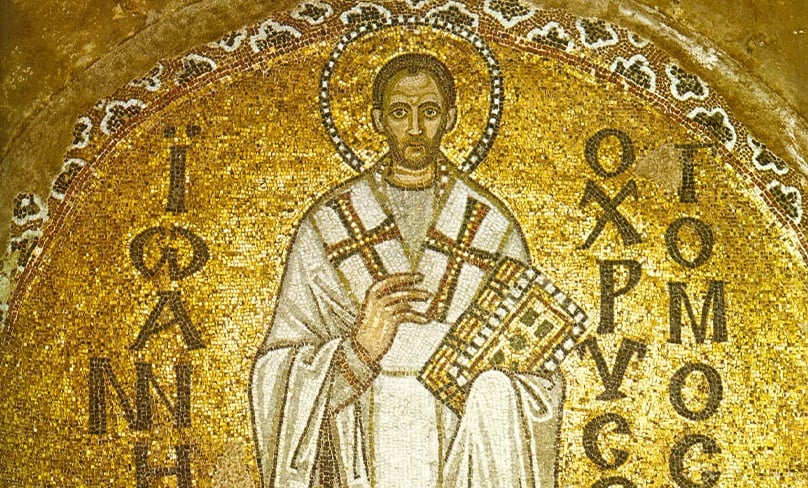
St John Chrysostom (13 November) was one of the greatest patriarchs who ever sat on the throne of Constantinople. He is celebrated in both the Maronite Liturgy and that of Byzantium, each of which has an anaphora in his name.
He had first been a priest in Antioch, where he achieved so bright a name that he was summonsed by the emperor to become patriarch of Constantinople.
When he was deposed, he was sent into exile on the Black Sea, and never returned. In the Orthodox Church, he is considered one of the three universal teachers, together with St Basil the Great (c.329-379) and St Gregory Nazianzus (the Theologian, c.329-390).
St John was probably born in 349 in Antioch, and died on 14 September 407. The name “Chrysostom” or “Gold Mouth” was given to him because of his eloquence.
In the year 368, John was baptised by Bishop Meletius, and became the bishop’s aide.
During this period, John lived at home with his widowed mother, studying scripture with Diodore, who taught not in an ordinary school, but what was called an asketerion.
It was not a monastery, but the young men who studied there regarded one another as “brothers.”
They were celibate, abstained from wine and meat, wore special clothes, and devoted themselves all day to religious duties, as they were not allowed secular employment.
In 372, John moved to some mountains near Antioch where an elderly Syrian monk directed him in the ascetical life for four years.
He then withdrew to a cave where he lived as a hermit for two years, and learnt the scriptures by heart.
In 378, John returned from his hermitage, having fasted so long that his health was damaged. However, he never lost his love of the solitary life.
He later wrote: “Monks contribute to the salvation of their fellow men, helping by their penances and their prayers those who are in charge of the church.”
John was ordained a priest in early 386 when he was probably 36 years of age. He served as a priest in Antioch, and became famous as a preacher.
It is thought that in this 12-year period he wrote the approximately 900 sermons that have survived. He preached frequently, during the week as well on Saturdays and Sundays.
To his surprise, in 398 he was made bishop of Constantinople. John was effectively kidnapped from Antioch, because the people would complain at his removal.
In Constantinople, there was substantial trouble with the Arians, who conducted popular night processions and sang hymns.
He spent so much time travelling, attending to various matters in the Eastern section of the Empire, that he had to appoint his archdeacon as administrator and the Syrian bishop Severian as preacher. He immediately established himself as a reformer.
As bishop, John was unusual: he did not take part in the social life of the city, but rather studied scripture and devoted himself to charitable works, caring for widows, virgins, deaconesses and the poor and establishing hospitals and hostels for travellers.
He tried to reform the lives of both clergy and laity, exhorting the laity not to store up excessive wealth.
He also cared for the liturgy, and established night liturgies and processions, even taking care that the Gothic (barbarian) population of Constantinople had liturgies. He exemplified his saying: “What the soul is in the body, let Christians be in the world.”
Against his will, he had to become involved in political affairs, in so far as political and religious affairs could be separated then in Constantinople.
He once said: “We must not mind insulting men, if by respecting them we offend God.”
He followed his own advice. He made enemies by his asceticism and exhortations to morality and modesty—a matter which the Empress Eudoxia especially resented.
It was such matters that had John Chrysostom exiled. After much trouble, he was put on trial at the Synod of the Oak in 403.
Although the synod went against him, he still served as bishop, and was not banished until 404, first to Cappadocia and eventually to the Eastern shore of the Black Sea, dying on route, in 407, at about the age of 58.
At the insistence of Pope Innocent I (402-417), his memory was rehabilitated and his bones taken first to Constantinople, and finally to Rome.
He is a splendid example of unswerving devotion the truth over the course of a life in which his life circumstances changed a good deal.
He said: “Every man is the painter and the sculptor of his own life.”
His story demonstrates the justice of this. He reminds us that no matter what may occur to us, there is nothing which can separate our wills from God.
